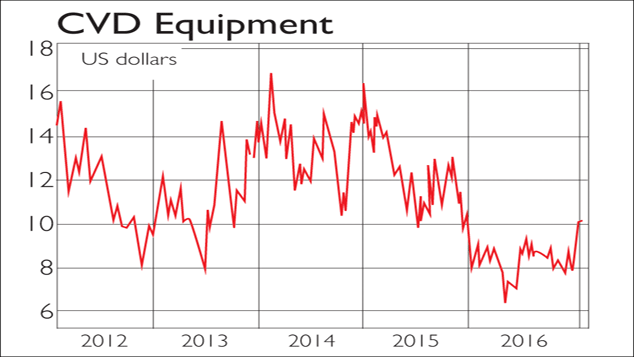The miracle material that could change the world
Graphene is 200 times stronger than steel and more conductive than silicon. Matthew Partridge investigates how to profit from it.


Graphene is 200 times stronger than steel and more conductive than silicon. Matthew Partridge investigates how to profit from it.
It was a roll of sticky tape that helped Andre Geim and Konstantin Novoselov at the University of Manchester win the Nobel Prize for physics in 2010 and usher in the development of a new material that may change the world. The two researchers stuck tape onto blocks of graphite the material used as "lead" in pencils and peeled it off to remove very thin layers of graphite. They then stuck more tape on top of the tape and peeled it off, to produce an even thinner layer. After repeating this many times, they dissolved the tape in solvent, ending up with layers just an atom thick.
In the process, they solved a problem that researchers had been wrestling with for several decades. A block of graphite consists of individual layers of carbon atoms arranged in a honeycomb pattern, with each layer held together with its neighbours by weak bonds that allow them to be easily separated or slide over each other. Scientists studying graphite had long been interested in producing single layers of graphite which are known as graphene but had been unable to do so in a way that did not affect the structure.
MoneyWeek
Subscribe to MoneyWeek today and get your first six magazine issues absolutely FREE

Sign up to Money Morning
Don't miss the latest investment and personal finances news, market analysis, plus money-saving tips with our free twice-daily newsletter
Don't miss the latest investment and personal finances news, market analysis, plus money-saving tips with our free twice-daily newsletter
The breakthrough by Geim and Novoselov, which happened in 2004, allowed the properties of graphene to be studied for the first time. And subsequent research showed that it had several remarkable properties. It is more than 200 times stronger than the comparable weight of steel. It is very good at conducting both heat and electricity.
It has high lubricity, which means it is very good at reducing friction. It's transparent, flexible and impermeable. This all means that it could have a vast range of applications. Imagine computers that were hundreds, or thousands, of times faster than today's fastest models, or bridges made up of layers as thin as paper. Some have even speculated that graphene could be used to build a lightweight elevator into space, doing away with the need for rockets. While some of these ideas may be more science fiction than reality, it's clear that the material has huge potential.
Starting from a blank slate
Commercialisation of that potential remains some way off. The whole industry is "starting from a blank canvas", says Jon Mabbitt, the chief executive officer of Applied Graphene Materials, one of the leading companies in the field. There are two main challenges in turning research into graphene into commercial applications. The first is extracting (or producing) graphene at a commercially viable price.
The second is to combine the individual layers of graphene produced in a way that can create much larger structures without affecting the core properties of the material. Hence he sees its greatest short-term potential in the areas that don't require a huge mass. Devising paints and coating that can increase both the strength and water resistance of an item is one area. Another is making better lubricants that can reduce friction, cutting down on wear and tear, and therefore increasing the lifespan of components.
A third area of application is in making composites more robust. Indeed, one sub-sector that has been an early adopter of the technology is the sporting-goods industry: for example, graphene is being added to fishing rods in order to make them more robust.
Fishing rods and paints may seem small steps compared with dreams of elevators into the sky, but Mabbitt is quick to emphasise that these are only the tip of the iceberg. Over the past decade, a large number of companies have started to enter the area, and those who have started to use graphene in their products are finding "very rapid adoption benefits". There are also indications that it has a huge amount of potential in transport and aeronautics, where demand is high for materials that can maintain performance while drastically reducing weight.
Five years away from the mainstream
Others involved in the area are even more optimistic about the near-term prospects for the commercialisation of graphene. Products that use the material have already started to enter the market, but "not on an enormous scale", says James Tour, professor of chemistry, materials science, nano-engineering and computer science at Rice University in Houston, Texas, who holds the third-largest number of graphene-related patents in the world. However, within the next two years this trickle is likely to become a flood as companies become more confident with the technology.Within five years we should reach a tipping point where increased awareness of graphene's potential means that it will become a major component of many products.
In some cases, graphene will replace established materials, he says. For example, the touchscreen displays in smartphones use an indium tin oxide coating. The problem is that indium tin oxide is not only relatively expensive, but global supplies are limited. The electronics giant Samsung, which has been funding a huge amount of research in South Korea, is now starting to use graphene as a substitute material. Not only does this reduce costs, but it also improves performance, since indium isn't that flexible. Even where graphene isn't a complete replacement, it still can be used in conjunction with other materials to improve performance.
For example, graphene is unlikely completely to replace silicon in transistors, because it doesn't have a "band gap" (put as simply as possible, this means that the electrons in graphene are structured in a way that means you can't vary the current passing through it, which is a problem given that's how you control electrical circuits). However, if you add even a small amount of graphene to silicon you can dramatically improve conductivity. This improves the processing power of computer chips. Similarly, batteries that have graphene in them have a longer lifespan than those without, as well as allowing lithium batteries to deal with higher temperatures.
Tour also sees substantial progress in the production of graphene. For example, Samsung has developed ways to grow significant amounts of high-quality material at high temperature. In cases where the quality of the graphene isn't so important, there have been significant reductions in the production costs. Dotz Nano, a firm with which Tour works, has devised ways to use coal to produce graphene-based "quantum dots" (tiny particles a few nanometres wide that have different properties to larger particles). Even the cheapest graphite from China costs $800 per ton, but coal can be as little as $10 per ton, meaning a huge reduction in costs.
Commercial interest in graphene is approaching a tipping point, says James Baker, business director of the National Graphene Institute (NGI) at the University of Manchester. The NGI was set up with funding from the UK government and the European Union to make sure that scientific discoveries in this field were exploited by business as quickly as possible in contrast to, say, carbon fibre, where commercialisation of research took much longer because "the scientific discoveries stayed within academia for the first decade".
Initially, Baker was mostly working with start-up companies, as the bigger firms were "slow to engage", but that's now changing. "With near term applications coming to market, their interest and involvement is increasing," he says, reeling off an impressive list of corporate partners from small British firms, such as Haydale and Thomas Swan, to huge engineering groups such as Rolls-Royce and Siemens.
Baker is particularly enthusiastic about the level of interest from the aerospace industry. Previously, the sector had seen graphene solely as "a long-term investment" rather than an immediate priority, he says, but firms now see an opportunity to save large amount of time and money by building better tools that could cut manufacturing times. The NGI is working with firms such as Airbus and BAE.
But despite the entry of these larger firms, Baker thinks that there is still a "role for all types of company", including start-ups, in commercialising graphene. Indeed, several bigger firms are trying to make up for lost ground by snapping up the smaller players.
What's the potential?
While graphene may be exciting, it remains niche for now, cautions Paul Lee, head of global research at Deloitte, a consultancy. He estimates that the size of market is still in the tens of millions and will possibly grow to more than $100m by the end of the decade. As relatively new technology, it is prone to overblown claims, he says: for example, the idea of "producing graphene in your kitchen" as one firm has trumpeted, is correct "only if that kitchen has a laboratory attached". In short, investors shouldn't get carried away yet.
Nonetheless, the markets for the materials that graphene is attempting to complement or substitute entirely are vast and may give an idea of its long-term potential if the technology is widely taken up. Composites such as carbon fibre are one of the key opportunities, say both Baker and Mabbitt. The global market for carbon fibre reached $2.15bn in 2015, and is growing at a rate of around 10%-13% a year, according to the German Federation of Reinforced Plastics. The total carbon composites market reached $17.9bn in 2015 and is also expanding quickly.
Paints and lubricants could be another key area. For example, the global paints and coatings market is worth $128bn, and expected to hit $173bn by 2020, a growth rate of around 6% a year, according to PS Market Research, while the global lubricants market will be worth $68bn a year within the next five years, according to Grand View Research. But perhaps the biggest single sector where graphene have a significant impact is the global semiconductor industry, which is worth $354bn a year, according to PwC. Quantum dots hold particular promise. BCC predicts that global sales of these should reach $3.4bn by 2021.
Finally, there is the strong possibility that demand for graphene could develop in ways no one could expect. "Our own bias is always to try to apply new materials and discoveries to existing problems and applications," says Tomas Palacios, a professor at MIT. When Herbert Kroemer invented the semiconductor laser, nobody knew that a few decades later it would enable the optical fibre and the internet, he points out. "The extreme properties of graphene and other two-dimensional materials will enable similar breakthroughs."
Five ways to invest in graphene
Firms such as Samsung Electronics and Airbus could be beneficiaries of graphene technology. Samsung is planning to incorporate graphene in a wide range of products, starting with smartphones and high-end televisions. Airbus is working to use graphene to produce lighter, tougher composites for its planes that can reduce total fuel costs and increase safety.
However, while you could make an investment case for both these stocks and many similar companies, their fortunes depend on far more than the commercialisation of graphene. If you want to invest directly in the sector, it inevitably means looking at small, early-stage companies, most of which are still loss-making. So it goes without saying that this only suitable for investors who are willing to take risks with a small part of their portfolio.
As more universities and companies spend time and money researching graphene, they will have to spend money on sophisticated tools to do so. CVD Equipment (Nasdaq: CVV) makes equipment that puts chemicals onto very thin layers of film. This is used in the production of solar cells, semiconductors and coatings. CVV makes a specialised range of machines that are used to produce graphene, under the brand name First Nano. It trades at around 15 times current earnings.

Haydale (Aim: HAYD) is a specialist in processing and handling graphene and similar materials, while its subsidiary, Haydale Composite Solutions, is involved in the production of composite materials. It is loss-making, but there is a chance that it might turn a profit for the first time later this year. It has recently begun negotiating agreements with other companies, such as Huntsman Advanced Materials and FlowtiteTechnology, to incorporate graphene into their products.
Applied Graphene Materials (Aim: AGM), run by Jon Mabbitt, was spun out of research at the University of Durham. It both produces its own graphene powder and works with other firms who want to use graphene in their products. Its main collaboration so far is with a fishing rod manufacturer, but it is working with a marine coatings firm, James Briggs, which is due to launch a graphene-based product later this year.
Like Haydale, AGM is currently not making a profit, but a successful secondary offering means that it has plenty of cash in hand. Regular MoneyWeek contributor Dr Mike Tubbs recommends listed venture capital firm IP Group (Aim: IPO), which holds large stakes in a wide range of university spinouts, including AGM.
Finally, Dotz Nano (Sydney: DTZ) uses coal to produce graphene quantum dots. It has research partnerships with Rice University, where James Tour, its chief scientific advisor, works, and with Ben-Gurion University in Israel. This month it concluded a marketing and sales deal with Strem Chemicals, which should help it sell its products around the world. Like Haydale and AGM it is running at a loss.
Get the latest financial news, insights and expert analysis from our award-winning MoneyWeek team, to help you understand what really matters when it comes to your finances.

-
 How cancelling unused direct debits could boost your pension by £37,000
How cancelling unused direct debits could boost your pension by £37,000A new year refresh of your spending could save you money and help boost your pension pot.
-
 NS&I cuts interest rates on 8 savings accounts
NS&I cuts interest rates on 8 savings accountsNS&I will now offer less attractive interest rates for customers wishing to lock their savings away to grow for one, two, three or five years.
-
 Governments will sink in a world drowning in debt
Governments will sink in a world drowning in debtCover Story Rising interest rates and soaring inflation will leave many governments with unsustainable debts. Get set for a wave of sovereign defaults, says Jonathan Compton.
-
 Why Australia’s luck is set to run out
Why Australia’s luck is set to run outCover Story A low-quality election campaign in Australia has produced a government with no clear strategy. That’s bad news in an increasingly difficult geopolitical environment, says Philip Pilkington
-
 Why new technology is the future of the construction industry
Why new technology is the future of the construction industryCover Story The construction industry faces many challenges. New technologies from augmented reality and digitisation to exoskeletons and robotics can help solve them. Matthew Partridge reports.
-
 UBI which was once unthinkable is being rolled out around the world. What's going on?
UBI which was once unthinkable is being rolled out around the world. What's going on?Cover Story Universal basic income, the idea that everyone should be paid a liveable income by the state, no strings attached, was once for the birds. Now it seems it’s on the brink of being rolled out, says Stuart Watkins.
-
 Inflation is here to stay: it’s time to protect your portfolio
Inflation is here to stay: it’s time to protect your portfolioCover Story Unlike in 2008, widespread money printing and government spending are pushing up prices. Central banks can’t raise interest rates because the world can’t afford it, says John Stepek. Here’s what happens next
-
 Will Biden’s stimulus package fuel global inflation – and how can you protect your wealth?
Will Biden’s stimulus package fuel global inflation – and how can you protect your wealth?Cover Story Joe Biden’s latest stimulus package threatens to fuel inflation around the globe. What should investors do?
-
 What the race for the White House means for your money
What the race for the White House means for your moneyCover Story American voters are about to decide whether Donald Trump or Joe Biden will take the oath of office on 20 January. Matthew Partridge explains how various election scenarios could affect your portfolio.
-
 What’s worse: monopoly power or government intervention?
What’s worse: monopoly power or government intervention?Cover Story Politicians of all stripes increasingly agree with Karl Marx on one point – that monopolies are an inevitable consequence of free-market capitalism, and must be broken up. Are they right? Stuart Watkins isn’t so sure.